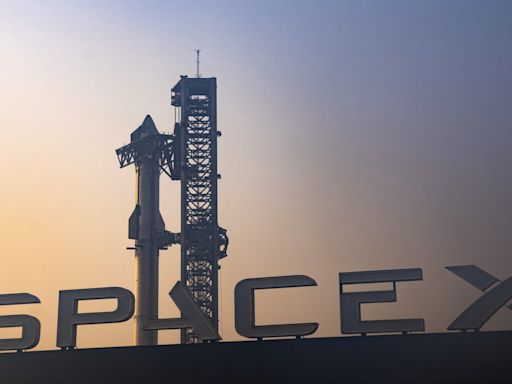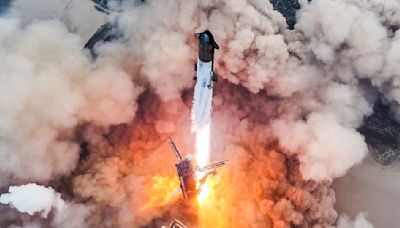Search results
A rocket (from Italian: rocchetto, lit. 'bobbin/spool') is a vehicle that uses jet propulsion to accelerate without using any surrounding air. A rocket engine produces thrust by reaction to exhaust expelled at high speed. Rocket engines work entirely from propellant carried within the vehicle; therefore a rocket can fly in the vacuum of space ...
Jun 30, 2021 · Rockets are our species' best way of escaping the atmosphere of Earth and reaching space. But the process behind getting these machines to work is far from simple. Here's what you need to know...
- 13 min
- Giles Sparrow,All About Space magazine
- SpaceX Starship 4th flight test looks epic in these stunning photos
- SpaceX Starship launches on nail-biting 4th test flight of world's most powerful rocket (video, photos)
- Watch SpaceX launch 4th test flight of Starship megarocket today
- Watch Boeing's Starliner arrive at ISS today on historic 1st astronaut mission
- SpaceX congratulates Boeing, ULA on 1st crewed Starliner launch
- Boeing's Starliner launches astronauts for 1st time in historic liftoff (photos, video)
- SpaceX lands FAA license for next Starship megarocket launch on June 6
- SpaceX targeting June 6 for next launch of Starship megarocket (photos)
- India launches nation's 1st 3D-printed rocket engine
- Rocket Lab launches 2nd shoebox-sized climate satellite for NASA (video)
Launching a rocket into space is one of humankind's crowning achievements. Learn about how rockets work, what happens during a launch, and how centuries of innovation made space exploration ...
- 6 min
- 5.4M
- National Geographic
- Overview
- General characteristics and principles of operation
rocket, any of a type of jet-propulsion device carrying either solid or liquid propellants that provide both the fuel and oxidizer required for combustion. The term is commonly applied to any of various vehicles, including firework skyrockets, guided missiles, and launch vehicles used in spaceflight, driven by any propulsive device that is independ...
The rocket differs from the turbojet and other “air-breathing” engines in that all of the exhaust jet consists of the gaseous combustion products of “propellants” carried on board. Like the turbojet engine, the rocket develops thrust by the rearward ejection of mass at very high velocity.
The fundamental physical principle involved in rocket propulsion was formulated by Sir Isaac Newton. According to his third law of motion, the rocket experiences an increase in momentum proportional to the momentum carried away in the exhaust,where M is the rocket mass, ΔvR is the increase in velocity of the rocket in a short time interval, Δt, m° is the rate of mass discharge in the exhaust, ve is the effective exhaust velocity (nearly equal to the jet velocity and taken relative to the rocket), and F is force. The quantity m°ve is the propulsive force, or thrust, produced on the rocket by exhausting the propellant,
Evidently thrust can be made large by using a high mass discharge rate or high exhaust velocity. Employing high m° uses up the propellant supply quickly (or requires a large supply), and so it is preferable to seek high values of ve. The value of ve is limited by practical considerations, determined by how the exhaust is accelerated in the supersonic nozzle and what energy supply is available for the propellant heating.
Britannica Quiz
36 Questions from Britannica’s Most Popular Science Quizzes
Most rockets derive their energy in thermal form by combustion of condensed-phase propellants at elevated pressure. The gaseous combustion products are exhausted through the nozzle that converts most of the thermal energy to kinetic energy. The maximum amount of energy available is limited to that provided by combustion or by practical considerations imposed by the high temperature involved. Higher energies are possible if other energy sources (e.g., electric or microwave heating) are used in conjunction with the chemical propellants on board the rockets, and extremely high energies are achievable when the exhaust is accelerated by electromagnetic means.
Nov 15, 2022 · KENNEDY SPACE CENTER, Fla. — NASA’s majestic new rocket soared into space for the first time in the early hours of Wednesday, lighting up the night sky and accelerating on a journey that will...
- 57 sec
- Kenneth Chang
Oct 17, 2023 · Learn about the different types of spaceships and rockets enabled by NASA for various missions in space, from low Earth orbit to the Moon and beyond. Explore the features, systems, and capabilities of each spacecraft and launch vehicle.
Jan 4, 2019 · Learn how rockets work, what stages they have, and what types of rockets exist. Find out how rockets send satellites, robots, animals, and people into orbit and beyond.





